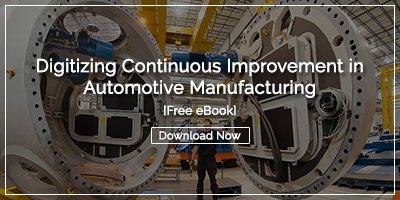 While initially implemented in the automotive sector, the Lean manufacturing continuous improvement methodology can help organizations in every industry operate more efficiently. Applying Lean principles paves the way for improved quality, higher customer satisfaction, lower costs, and increased employee engagement. Far from a simple project management approach, Lean is a way of thinking that leads to innovation and improvement.
While initially implemented in the automotive sector, the Lean manufacturing continuous improvement methodology can help organizations in every industry operate more efficiently. Applying Lean principles paves the way for improved quality, higher customer satisfaction, lower costs, and increased employee engagement. Far from a simple project management approach, Lean is a way of thinking that leads to innovation and improvement.
Background
The Lean manufacturing approach got its start in Japan. In an effort to improve quality, increase sales, reduce waste, and become more profitable, Eiji Toyoda embarked on a mission to revolutionize Toyota's manufacturing process. He was inspired by a visit to the Ford facility in Detroit, Michigan, where he collaborated with Taiichi Ono to develop a series of continuous improvement techniques. Together they are known as the Toyota Production System.
The effort paid off, and Toyota became one of the world's most efficient companies with a culture envied by others. As a result, many business analysts and corporate leaders began to study and replicate the approach, including the founders of the Lean Enterprise Institute, James Womack and Dan Jones.
Womack and Jones published what is considered to be the ultimate guide to running a Lean organization, "Lean Thinking: Banish Waste and Create Wealth in Your Corporation." The book introduced five core principles that form the foundation of Lean.
The Five Central Lean Manufacturing Principles
The five Lean manufacturing principles that set the stage for Toyota's success are aligned to produce maximum value for the customer with minimum waste. They are:
Identify Value
The first step on a Lean journey is identifying value in the eyes of the customer. It requires isolating precisely what customers find meaningful and worthwhile from their perspective. Customer value is the driving force behind why they buy from you vs. your competitors. Therefore, developing a deep understanding of what drives this choice is essential. If your customers do not find that the value of your product or service outweighs the cost, they will look elsewhere.
Part of establishing value is defining a target price. This is different than the cost + pricing model as it allows you to set pricing based on what the customer is willing to pay. Pricing based on customer value is frequently more profitable while still being acceptable to the customer.
It is important to note that what you and your team think is valuable and what customers actually value may not be the same. It is essential to conduct research and ask the customer rather than simply guessing. To establish value accurately, you'll want to uncover their requirements, expectations, and pain points. All other principles depend on this foundation, so it is essential to get it right.
Map the Value Stream
In Lean, the value stream refers to the complete product or service lifecycle, from ideation to disposal and every process in between. It includes the supply chain, raw materials, production processes, product features, and transportation. The value stream mapping method is essential for identifying waste and opportunities for improvement.
Once the current state is mapped, you will identify some activities and processes necessary to create value and some that don't add value but are unavoidable due to regulations or technical limitations. But you will also notice parts of the map that fall into a third category, those that are not required and do not add value. That's your opportunity to use Lean thinking to eliminate waste.
Create Flow
In Lean, Flow means the value stream's consistent creation and smooth movement. It's somewhat abstract, but it is essential to understand. Waste occurs when the value stream stops moving forward due to some blockage or impediment. The waste may take the shape of lost time, additional motion or transportation, unnecessary storage cost, or spoilage. In addition, choppy flow makes just-in-time production and delivery impossible.
To create consistent flow, there needs to be a transformation from batch processing and siloed operations to level production. When companies make this shift, they can launch products faster by taking them from ideation to production in significantly less time. In addition, they can improve their turnaround cycles from order to production and stay flexible enough to pounce on unexpected opportunities.
Establish Pull
The traditional approach to manufacturing in the west is centered around a forecast. Sales leaders estimate how much product they'll be able to sell in a given period. Raw materials are then ordered, and manufacturing schedules are created based on these predictions to meet the expected orders. Unfortunately, sales forecasts aren't always accurate. If the demand is higher than anticipated, production might be unable to keep up. On the other hand, if the sales don't materialize, profitability suffers.
A pull system helps eliminate this problem by ensuring that nothing is made before being ordered. In this case, every product is built to order based on customer demand. As a result, supply never outstrips demand, eliminating a significant amount of waste.
Of course, this isn't a simple endeavor. The process must be flexible and quick enough to deliver products as needed. Strong Lean leadership and continuous internal communications are necessary so that every operation in the value chain knows what is coming up to them. If the previous three principles are well executed, companies are in an excellent position to establish pull successfully.
Seek Perfection
Sometimes folks raise their eyes when we mention this Lean principle because, of course, perfection is not possible. But the pursuit of perfection is why Lean companies are not satisfied with just the previous four concepts. Instead, they are always searching for additional ways to improve and create the conditions for more innovation. Continuous improvement means constantly attacking waste and constant effort to create customer value. The result is an unrelenting upward trajectory of efficiency, customer satisfaction, and profitability.
In Lean circles, the continuous pursuit of perfection is often referred to as Kaizen. Kaizen comes from the Japanese words for good (kai) and change (zen). Kaizen is about making small, incremental changes daily. It involves every worker from the C-suite to the front lines, with everyone vigilant for improvement opportunities. In a culture of Kaizen, there is no risk of pointing out problems because the goal is not to blame but to seek the root cause of issues and address them at the source. The focus is on processes and operations, not employee errors.
As it should be clear, Lean isn't a short-term project or one-time event. It is a way of operating that is constantly adjusted to respond to changing conditions. It can't be accomplished without strong support from leaders and constant attention to operations. Many organizations find that Lean manufacturing software helps to ensure that improvement stays top of mind and that the impact of Lean efforts is calculated.
Supporting Techniques
In addition to software, several Lean techniques help organizations implement the five central principles. Follow the links to learn more about:
- The 5 Whys Problem Solving Technique
- 5S Workplace Organization
- Kanban Boards (Support for flow and pull)
- The PDSA Improvement Cycle
- A3 Reporting
- Hoshin Kanri Strategy Deployment
Each of these Lean principles and techniques aligns the organization around a singular goal, providing maximum value to the customer with the least amount of waste possible. This is the key to profitability and long-term success, and it explains why Lean manufacturing has been adopted by so many diverse organizations worldwide.

![[Watch Now] Components of an Employee-Led Lean Initiative](https://blog.kainexus.com/hubfs/hub_generated/resized/2f2fa82d-49d8-4190-9da2-b23616a71ee5.jpeg)


Add a Comment